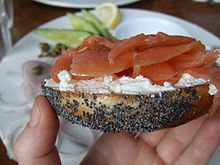
Dill is an annual herb in the celery family Apiaceae. It is native to North Africa, Iran, and the Arabian Peninsula; it is grown widely in Eurasia, where its leaves and seeds are used as a herb or spice for flavouring food.

A kipper is a whole herring, a small, oily fish, that has been split in a butterfly fashion from tail to head along the dorsal ridge, gutted, salted or pickled, and cold-smoked over smouldering wood chips.
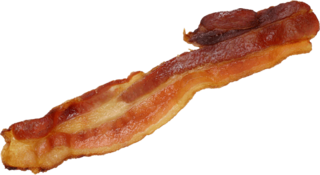
Bacon is a type of salt-cured pork made from various cuts, typically the belly or less fatty parts of the back. It is eaten as a side dish, used as a central ingredient, or as a flavouring or accent.
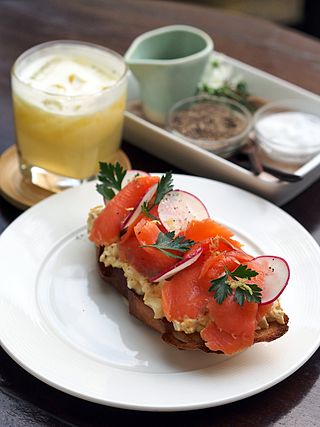
Smoked salmon is a preparation of salmon, typically a fillet that has been cured and hot or cold smoked.
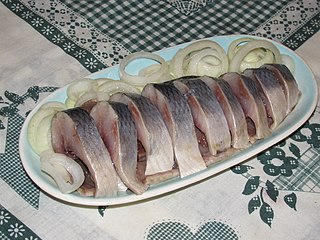
Pickled herring is a traditional way of preserving herring as food by pickling or curing.
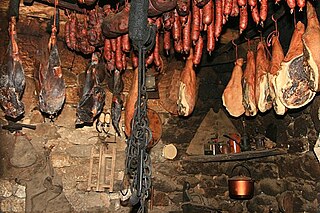
Smoked meat is the result of a method of preparing red meat, white meat, and seafood which originated in the Paleolithic Era. Smoking adds flavor, improves the appearance of meat through the Maillard reaction, and when combined with curing it preserves the meat. When meat is cured then cold-smoked, the smoke adds phenols and other chemicals that have an antimicrobial effect on the meat. Hot smoking has less impact on preservation and is primarily used for taste and to slow-cook the meat. Interest in barbecue and smoking is on the rise worldwide.

Gravlax or graved salmon is a Nordic dish consisting of salmon that is cured using a mix of salt, sugar and dill. It is garnished with fresh dill or sprucetwigs and may occasionally be cold-smoked afterwards. Gravlax is usually served as an appetizer, sliced thinly and accompanied by hovmästarsås, dill and mustard sauce, either on bread or with boiled potatoes.

Smørrebrød, smørbrød "butter bread" (Norwegian), or smörgås "butter goose" (Swedish), is a traditional open-faced sandwich in the cuisines of Denmark, Norway and Sweden that usually consists of a piece of buttered rye bread, topped with commercial or homemade cold cuts, pieces of meat or fish, cheese or spreads, and garnishes.
Norwegian cuisine in its traditional form is based largely on the raw materials readily available in Norway and its mountains, wilderness, and coast. It differs in many respects from continental cuisine through the stronger focus on game and fish. Many of the traditional dishes are the result of using conserved materials, necessary because of the long winters.

An appetizing store, typically in reference to Jewish cuisine in New York City, particularly Ashkenazi Jewish cuisine, is a store that sells "food that generally goes with bagels", although appetizings can also be served with a variety of breads. Appetizings include smoked and pickled fish and fish spreads, pickled vegetables, cream cheese spreads and other cheeses.
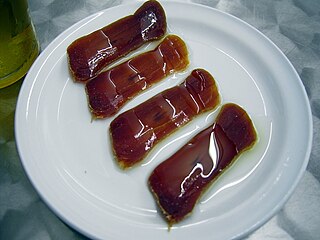
Mojama is a Mediterranean delicacy consisting of filleted salt-cured tuna, typically found in the Murcia and Andalusia regions of Spain, particularly in Huelva and Cádiz or in Portugal in the region of Algarve. Bluefin or yellowfin tuna are the most common varieties used.

Smoked fish is fish that has been cured by smoking. Foods have been smoked by humans throughout history. Originally this was done as a preservative. In more recent times fish is readily preserved by refrigeration and freezing and the smoking of fish is generally done for the unique taste and flavour imparted by the smoking process.

Cured fish is fish which has been cured by subjecting it to fermentation, pickling, smoking, or some combination of these before it is eaten. These food preservation processes can include adding salt, nitrates, nitrite or sugar, can involve smoking and flavoring the fish, and may include cooking it. The earliest form of curing fish was dehydration. Other methods, such as smoking fish or salt-curing also go back for thousands of years. The term "cure" is derived from the Latin curare, meaning to take care of. It was first recorded in reference to fish in 1743.

Fish preservation is the method of increasing the shelf life of fish and other fish products by applying the principles of different branches of science in order to keep the fish, after it has landed, in a condition wholesome and fit for human consumption. Ancient methods of preserving fish included drying, salting, pickling and smoking. All of these techniques are still used today but the more modern techniques of freezing and canning have taken on a large importance.

Gwamegi is a Korean half-dried Pacific herring or Pacific saury made during winter. It is mostly eaten in the region of North Gyeongsang Province in places such as Pohang, Uljin, and Yeongdeok, where a large amount of the fish are harvested. Guryongpo Harbor in Pohang is the most famous.

A bagel and cream cheese is a food pairing that consists, in its basic form, of a sliced bagel spread with cream cheese. Bagels with cream cheese are traditionally and most commonly served open-faced, sliced horizontally and spread with cream cheese and other toppings.

American Jewish cuisine comprises the food, cooking, and dining customs associated with American Jews. It was heavily influenced by the cuisine of Jewish immigrants who came to the United States from Eastern Europe around the turn of the 20th century. It was further developed in unique ways by the immigrants and their descendants, especially in New York City and other large metropolitan areas of the northeastern U.S.

